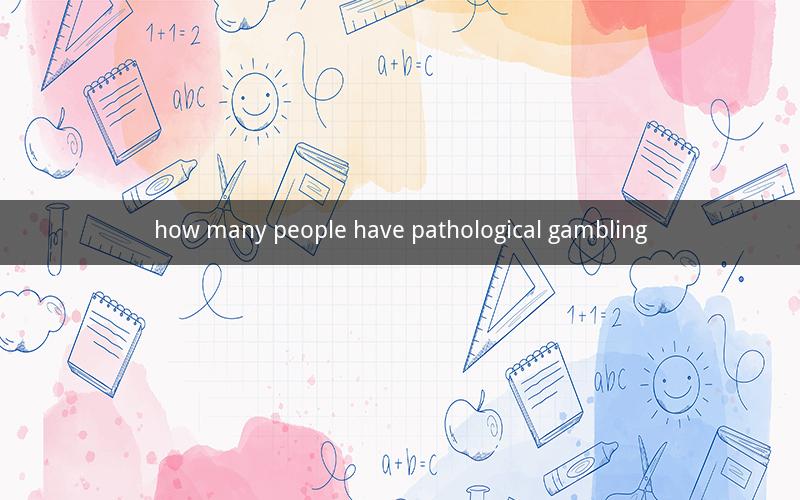
Pathological Gambling: An Overview of its Prevalence
Table of Contents
1. Introduction to Pathological Gambling
2. Defining Pathological Gambling
3. The Prevalence of Pathological Gambling
4. Factors Contributing to Pathological Gambling
5. Impact of Pathological Gambling on Individuals and Society
6. Diagnosing Pathological Gambling
7. Treatment and Support for Pathological Gamblers
8. Prevention Strategies and Public Awareness
9. Case Studies and Personal Stories
10. Conclusion
1. Introduction to Pathological Gambling
Pathological gambling, often referred to as gambling disorder, is a serious condition characterized by the inability to control or stop gambling despite negative consequences. It affects individuals from all walks of life and can lead to significant personal, financial, and social problems.
2. Defining Pathological Gambling
The term "pathological gambling" comes from the Diagnostic and Statistical Manual of Mental Disorders (DSM-5), which defines it as a pattern of gambling behavior that leads to significant distress or impairment. Key symptoms include the inability to stop gambling, preoccupation with gambling, lying to hide gambling activities, and chasing losses.
3. The Prevalence of Pathological Gambling
Determining the exact number of people with pathological gambling is challenging due to underreporting and the nature of the disorder. However, various studies have provided estimates of its prevalence. According to the National Council on Problem Gambling, approximately 2-3% of the adult population in the United States is affected by pathological gambling.
4. Factors Contributing to Pathological Gambling
Several factors contribute to the development of pathological gambling. These include genetic predisposition, environmental influences, and personal vulnerabilities. Research suggests that individuals with a family history of gambling problems or mental health disorders such as depression or anxiety may be at higher risk.
5. Impact of Pathological Gambling on Individuals and Society
The impact of pathological gambling on individuals and society is profound. Individuals with gambling disorders often experience financial ruin, relationship problems, and legal issues. Societally, the costs associated with pathological gambling, including lost productivity and healthcare expenses, are substantial.
6. Diagnosing Pathological Gambling
Diagnosing pathological gambling requires a comprehensive evaluation by a healthcare professional. The DSM-5 provides a checklist of criteria that must be met to diagnose the disorder. These criteria include experiencing a significant amount of time thinking about gambling, needing to gamble more money to achieve the desired excitement, and experiencing restlessness or irritability when attempting to stop gambling.
7. Treatment and Support for Pathological Gamblers
Treatment for pathological gambling typically involves a combination of psychotherapy, medication, and support groups. Cognitive-behavioral therapy (CBT) is particularly effective in helping individuals develop healthier gambling behaviors and coping strategies. Support groups, such as Gamblers Anonymous, also provide valuable peer support and resources.
8. Prevention Strategies and Public Awareness
Preventing pathological gambling involves raising public awareness about the risks and consequences of gambling. Education campaigns, school-based programs, and community outreach efforts can help individuals recognize the signs of gambling problems and seek help early. Additionally, responsible gambling initiatives and regulations can help reduce the availability and accessibility of gambling opportunities.
9. Case Studies and Personal Stories
Case studies and personal stories of individuals struggling with pathological gambling provide valuable insights into the challenges faced by those affected. These stories often highlight the emotional, financial, and social consequences of the disorder and the importance of seeking help.
10. Conclusion
Pathological gambling is a complex and challenging disorder that affects many individuals. Understanding its prevalence, contributing factors, and treatment options is crucial for raising awareness and providing support to those in need. As society continues to grapple with the issue of gambling addiction, it is essential to develop effective prevention strategies and support systems to help individuals overcome this devastating condition.
Questions and Answers
1. Q: What is the most common age group affected by pathological gambling?
A: The most common age group affected by pathological gambling is adults between the ages of 20 and 50.
2. Q: Can pathological gambling be cured?
A: While there is no guaranteed cure for pathological gambling, it can be effectively managed and treated with appropriate interventions.
3. Q: How can I tell if someone is a pathological gambler?
A: Look for signs such as preoccupation with gambling, lying about gambling activities, financial problems, and neglecting personal responsibilities.
4. Q: Are there any medications available to treat pathological gambling?
A: Some medications, such as antidepressants and mood stabilizers, may be prescribed to help manage symptoms of pathological gambling.
5. Q: Can pathological gambling lead to legal problems?
A: Yes, pathological gambling can lead to legal problems, including fraud, theft, and other criminal activities.
6. Q: How can I support a loved one who is struggling with pathological gambling?
A: Offer your support, encourage them to seek help, and be patient as they work through their addiction.
7. Q: Are there any support groups available for pathological gamblers?
A: Yes, support groups such as Gamblers Anonymous provide peer support and resources for individuals struggling with gambling addiction.
8. Q: Can pathological gambling affect children and adolescents?
A: Yes, children and adolescents can be affected by pathological gambling, either through their own gambling or by being exposed to a family member's gambling problems.
9. Q: How can I prevent pathological gambling in my community?
A: Promote responsible gambling practices, provide education on the risks of gambling, and support local programs aimed at preventing gambling addiction.
10. Q: What is the most effective treatment for pathological gambling?
A: The most effective treatment for pathological gambling is a combination of cognitive-behavioral therapy, support groups, and medication, tailored to the individual's needs.